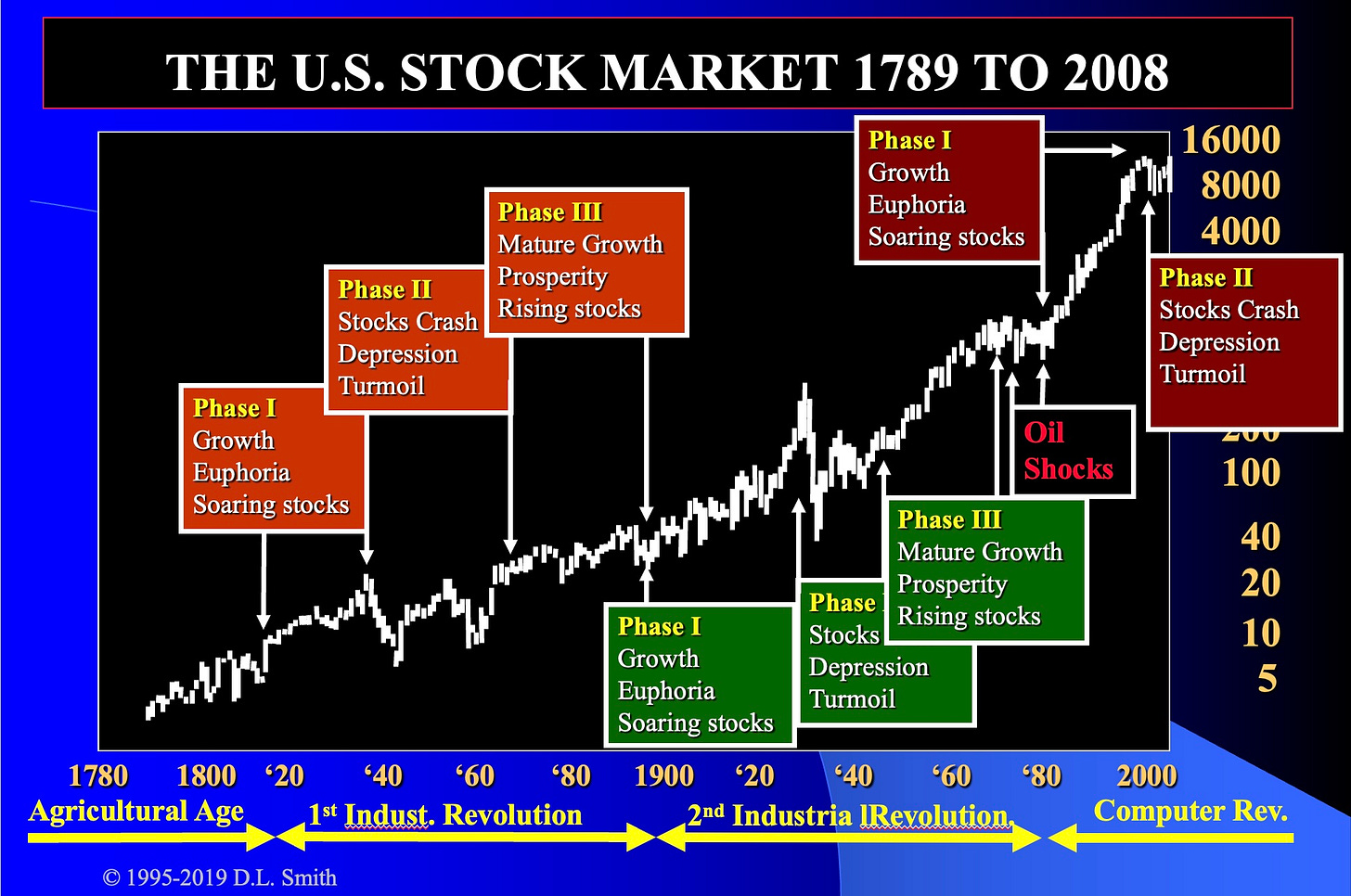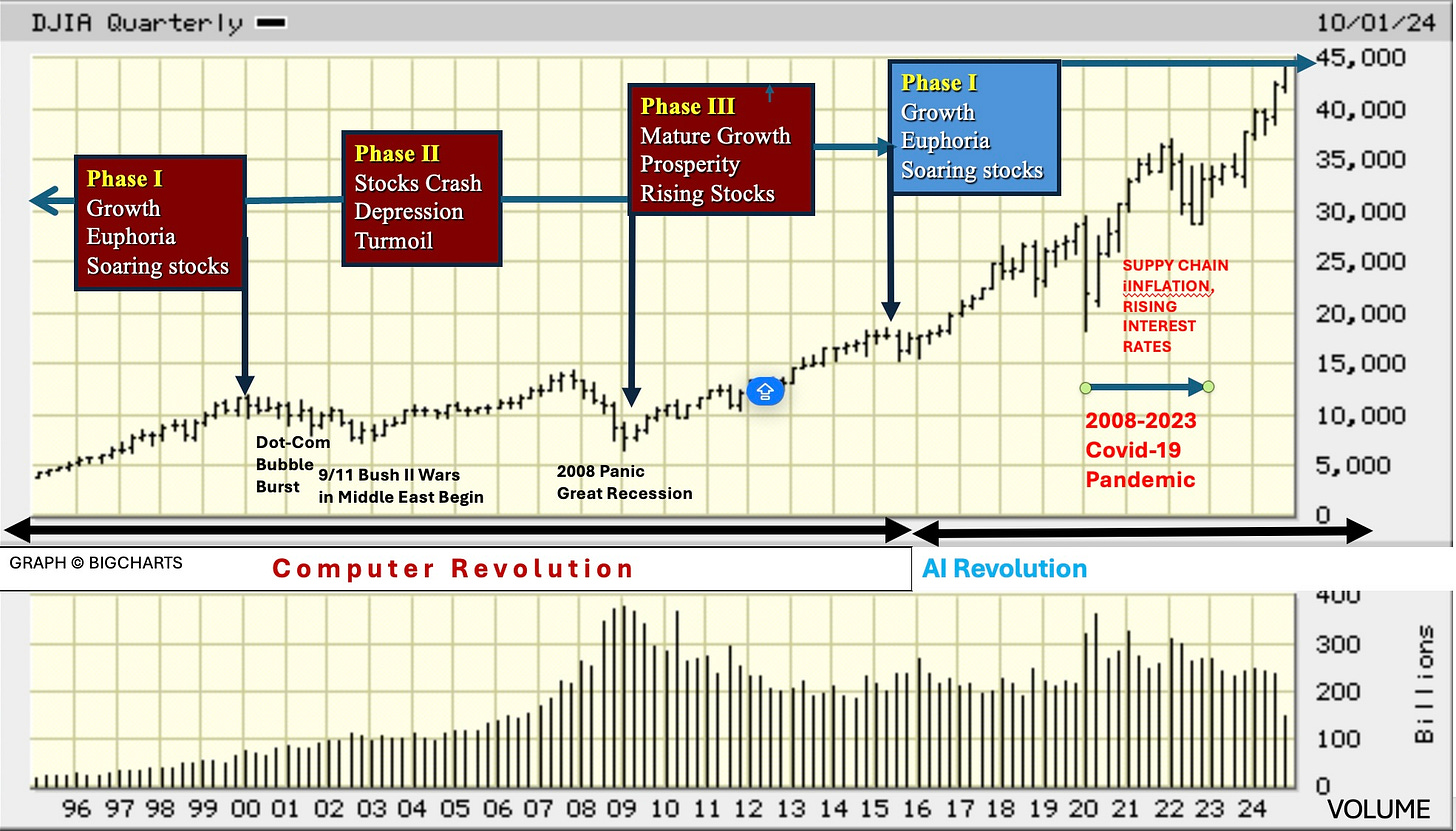THE UPSIDE OF THE DOWNSIDE -- PART II
MEGACYCLES: Technology and the Economy and Financial Markets
Alright then. Let’s dive into the past. It’s going to get a bit wonky, but stick with it; we’ll come out the other side with some useful concepts providing essential context for what we’re going through now and can expect in the future. But first, a quick review:
Part I of this series outlined an overarching theme: the U.S. election of 2024 reprises the election of 1928, when the well-meaning but misguided Republican candidate, Herbert Hoover, suffered the misfortune of ascending to the presidency a year before the stock market crashed and the economy sank into the Great Depression. I suggested that present conditions, echoing fundamental technological, economic, financial, and political developments preceding the 1928 election, presage a similar fate for Hoover’s malevolent doppelganger, Donald Trump. And, human nature being what it is, just as the backlash to Hoover’s Great Depression regenerated a new liberal political consensus in 1932 with the election of Franklin Delano Roosevelt offering a New Deal, a similar backlash to a disastrous Trump presidency will open the path to a new national agenda needed to repudiate the oligarchy, rebuild the middle class, restore democracy, reform and rebalance the government, and reconstruct the economy to meet the necessities of the new technological era. So, like I said: “It’s bad. It sucks, and it’s going to get worse before it gets better.” Buckle up.
Then, as now, technology transformed the economy, producing radical changes in almost every facet of the human enterprise: production methods and products; the occupational distribution of the labor force[ the content and processes of education and vocational training; the allocation of time for work and leisure; the source, distribution, and definition of wealth; the extension of credit; the methods of communication and travel; the location and architecture of workplaces and residences; diet; lifestyle; and, especially, politics. I lack the space to test your patience with descriptions of all the significant changes in the visual and performing arts, fashion, literature, entertainment, language, academics, and other aspects of human existence. Suffice it to say that virtually everything changes when new dominant technology and energy combinations emerge in what I call Megacycles, and others (like Kondratieff and Toffler) call “waves,” which I’m about to share with you.
MEGACYCLES
The common denominator of conditions in 1928 and 2024 is vast, rapid, global discombobulating change and explosive economic growth triggered by new technology and sources of energy, producing what I call Megacycles..” Historically, Megacycles have progressed in three phases with the following characteristics:
I. Exponential creation of new enterprises and jobs associated with the new technology, spurring explosive economic growth. “Good times” (The Great Gatsby) and the emergence of a new oligarchy and class structure (HBO series The Gilded Age), unsettling displacement of prior dominant enterprises and occupations (Schumpeter’s “creative destruction”) (The Grapes of Wrath) inducing simmering political discontent among those slow to adapt to the inevitable changes wrought by technology, in turn producing contentious division in society between those who successfully adapt to the new economy and those who don’t (Gone With The Wind). Euphoria generated by extraordinary profits from the new technology incites greed (Wall Street), eventually leading to over-investment in new technology and energy, creating dangerous, credit-fueled bubbles in stock, bond, and real estate markets underwritten by surging new wealth (The Wolf of Wall Street)).
II. Multiple crashes and panic in stock, bonds, and real estate markets as speculative bubbles burst (The Big Short), undermining investor confidence and capital investment, resulting in credit crunches (Too Big to Fail), great depressions, and skyrocketing unemployment, hunger, and homelessness (Modern Times). Political discontent boils over, leading to a sometimes violent, revolutionary shift in political consensus displacing the incumbents ( Hitler in Germany: Hitler, The Rise of Evil) and Roosevelt in the U.S.: PBS Documentaries: The Roosevelts, an Intimate History Episodes 5 and 6 (2014) and American Experience: FDR Season 7 Episodes 1 and 2 (1994)), followed, thus far, by war serving the dual purpose of unifying the country and reconstituting the economy (The War (2007), a documentary series by Ken Burns and Lynn Novick).
III. Postwar peace and prosperity based on sustained mature growth of the new energy-technology combination. Relatively benign economic and investment cycles trend upward in an extended period of generally “good times” (The Best Years of our Lives)—until the next Megacycle comes along.
Stock prices, as exemplified by the Dow Jones Industrial Average (reconstructed for the period before its inception in 1896), provide a useful surrogate barometer for the economy as a whole, illustrating this repeating 3-phase pattern during three competed Megacycles in the span of the last two centuries: The First and Second Industrial Revolutions and the Computer Revolution, the characteristics of which will be explained by the graphs below. NB: The first graph ends in 2008 with phases I and II of the third Megacycle, the Computer Revolution. The second graph below will pick up the Megacycle story from the tail end of Phase I of the Computer Revolution through Phases II and III, followed by the beginning of a fourth Megacycle, the Artificial Intelligence Revolution, beginning during the second decade of the 21st century, ten years ago. The second graph ends in the present, revealing the continuation of Phase I of the Artificial Intelligence Revolution, interrupted briefly by the exogenous perturbation of the Coronavirus/Covid Pandemic in the early 2020s, to be followed at some point by yet another turbulent Phase II, according to the Megacycle model. I’ll discuss the possible timing of the shift in Part III.
The history of the U.S. stock market from its inception in 1789 (three years before the Buttonwood Agreement of 1792 as the founding document of the New York Stock Exchange) to 2008 reveals the specific timing of the 3-phase Megacycle pattern: Two phases of technologically-driven growth bracketing a middle phase of economic, financial and socio-political turmoil.
·First Industrial Revolution (ca. 1780s in Britain, ca. 1820s in the U.S. to ca.1895) was driven when mechanical technology melded with coal as the prime mover. The steam engine, railroads, steel foundries, and mechanized textile production symbolize the “Gilded Age,” with “robber-barons-turned-philanthropists” Cornelius Vanderbilt (railroads) and Andrew Carnegie (steel) as leading innovators and tycoons of the period. Phase II began with the Crash and Depression beginning in 1837 and, followed by another in 1857 ending with the Civil War (1861-1865), followed by sustained growth in Phase III until the Second Industrial Revolution.
Second Industrial Revolution (ca. 1895 to 1980, which I sometimes call the “Petro-Industrial Revolution”), was driven by electro-mechanical technology and hydrocarbons. Automobiles, oil, and electricity are emblematic of the age, with Henry Ford, Harvey Firestone, John D. Rockefeller, and Thomas Edison as the corresponding leading innovators and tycoons. The early stage of the Petro-Industrial Revolution, by some accounts, is divided into two or three separate revolutions marked by various improvements in production methods, panics, contractions, World War I, and the “Roaring Twenties.” However, since these perturbations, driven by the same electro-mechanical/oil combination, remain within an upward-trending stock-market channel, I group them within Phase I of the Second Industrial Revolution beginning in around 1895 until the Crash of 1929, signaling the beginning of Phase II followed by the Great Depression of the 1930s, culminating in World War II, during which Phase III began, lasting (with a pause during the exogenous perturbation of the Oil Shocks between 1973-1982) until the beginning of the Computer Revolution around 1980.
The Computer Revolution, Phase I began around 1980 with the introduction of the personal computer and related innovations driven by electronic technology (originating with the invention of the transistor by Bell Labs in 1947), with Steve Jobs, Bill Gates, Jeff Bezos, Mark Zuckerberg, Elon Musk, Larry Page, Sergey Brin, and many other familiar names as prominent innovators, tycoons and oligarchs.
The Computer Revolution Megacycle traversed Phase II, beginning with the Dotcom Bust (2000-2003) and recession, followed by the 2008 Crash and Great Recession (2008-2009). Phase III then began in 2009 and lasted until the beginning of the Artificial Intelligence Revolution around 2015, give or take.
The Artificial Intelligence Revolution began arguably with Phase I beginning during the second decade of the 21st century in the Deep Learning Era as productivity soared with transformative applications such as AI-powered chatbots, translation tools, and automated documentation. Additional productivity gains stemmed from automation at scale with AI tools like robotic process automation in factories and automating repetitive tasks in banking and insurance, tools for design, video editing, and content generation in creative industries. After a pause occasioned by the Coronavirus/COVID pandemic beginning in the early 2020s (an exogenous variable, like the Oil Shocks of the 1970s, referred to in Wall Street as a “black swan” event) producing an immediate panic, stock market crash and recession in 2020-early 2021 followed by a recovery and another market swoon in 2022 due to worldwide inflationary Covid supply-chain disruptions driving up interest rates. The AI Revolution shifted into high gear with the introduction of Generative AI in 2022 (Open AI’s GPT series and DALL E), propelling stocks skyward. If past is prologue, the U.S. and world economies will undergo another crash and great depression when the AI Revolution enters into Phase II for reasons I will explain in Part III. Forewarned is forearmed: Phase II is the Megacycle interval of maximum danger. Whether the accompanying political upheaval will be merely turbulent or marred by violent revolution and/or foreign war remains to be seen.
SUMMING UP:
In Part II, you were introduced to the concept of Megacycles: Profound transformations of the human enterprise wrought by changes in dominant technology, usually coupled with a change in the dominant form of energy. This concept provides context essential to understanding virtually all events in human history. In unifying science, economics, finance, and politics, Megacycle theory is the social sciences equivalent to the elusive “unified field theory” in physics, with similar predictive value. Megacycles unfold in 3 phases:
Phase I: Exponential creation of new enterprises and jobs associated with the new technology, spurring explosive economic growth and soaring stock, bond and real estate prices. “Good times.”
Phase II: Multiple crashes and panic in stock, bonds, and real estate markets as speculative bubbles burst, undermining investor confidence and capital investment, causing severe economic contractions and high unemployment: “Hard times” encompassing radical political change.
Phase III: Postwar peace and prosperity producing sustained mature growth and relatively benign economic and investment cycles: “Good times,” often interrupted by “black swan” perturbations, such as the Oil Shocks of the 1970s and Covid-19 Pandemic of the early 2020s).
We reviewed the timing and consistent repetition of these phases in three completed Megacycles: the First and Second Industrial and Computer Revolutions, concluding with the beginning (Phase I) of the Artificial Intelligence Revolution currently underway. Repetition of the Megacyclical pattern suggests that we are approaching Phase II, the most dangerous interval of the current Megacycle with the most dangerous president in U.S. history at the helm. What could possibly go wrong?
***************************************
In Part IIIA,B and C, we will delve more deeply into the mechanics of Megacycles and likely timing of the Artificial Intelligence Revolution’s anticipated Phase II crash and great depression and reveal the economic and financial forces triggering this calamity, including an assessment of the impact of the president-elect’s announced policies.
In Part IV, we will address the political dimension of Megacycles, further exploring the notion that Newton’s third law of motion (Every action produces an equal and opposite reaction) applies to politics. Stay tuned.
*****************************************
I’m grateful for the surge of new subscribers in enthusiastic response to Part I of this series and hope the many followers will subscribe (it’s free) and take Mike Monett’s recommendation (Thank you, Mike):
****************************************
For earlier posts explaining and debunking Reaganomics, see:
REAGAN’S LEGACY: “It Ain’t Just a Question of Misunderstood,”




Brilliant analysis, as usual, David. Let me add two sledgehammer issues that could make the next 30 years unlike anything humans have faced in the past: the enormous, worldwide impact of climate change, causing huge migrations, famines, floods and other catastrophes that humans have never dealt with on this scale; and the use of nuclear weapons by desperate leaders that escalates beyond our imagination.
Great stuff, David, thank you for this.
To me, the one piece of the analysis that is missing is that the acceleration of our technological capabilities is not linear, it's exponential. We are not just incrementally improving our capacity to produce products that are more valuable than the energy invested in them, we are building the capability to have effectively unlimited energy, and both physical and algorithmic robots (AI) that can do most of the labor required to create abundance. Very few people, I think, appreciate how dramatically greater our technological capabilities are likely to be in a decade or two if current trend lines continue (Azeem Azhar is good on this, as is Dario Amodei, link below).
The second piece that is missing is that the conditions in which the exploited working class are working in the developed world are far less dire than they were a century ago, before the great depression. And conditions in the developing world have been improving at a pace that is faster than most of our liberal brethren acknowledge, causing people in the developing world to be far more optimistic about the future than wealthy liberals.
A third note is that we have more sophisticated (though still imperfect and limited) methods for managing economic cycles than we did a century ago.
I am not suggesting that societal collapse for the reasons your outline is not possible -- it IS a scary time, and the combination of anti-democratic populist leaders and ever more powerful surveillance technology (Harari's new book Nexus is good on this), poses a dire threat to our future.
But what I am saying is that our current conditions are far different from the conditions that lead to the great depression some 95 years ago. I am not convinced by the argument that an economic collapse is immanent.
Where I do agree with you, however, is that this is another historical moment when the oligarchs and political leaders must decide to make fundamental changes to how wealth is distributed in order to stabilize our future and shore up the future of democracy. Because just as the tools available for productivity enhancement are growing more powerful exponentially right now, so to are the tools available to autocrats. Tech companies are becoming entities with the power of nation states, and the quality of their cultures and leadership may prove to be almost as important as those of our governments. (More on that here for those curious - https://bookoftheday.nextbigideaclub.com/p/the-dawn-of-superintelligence-is)
Thank you for this and I look forward to the next installment!